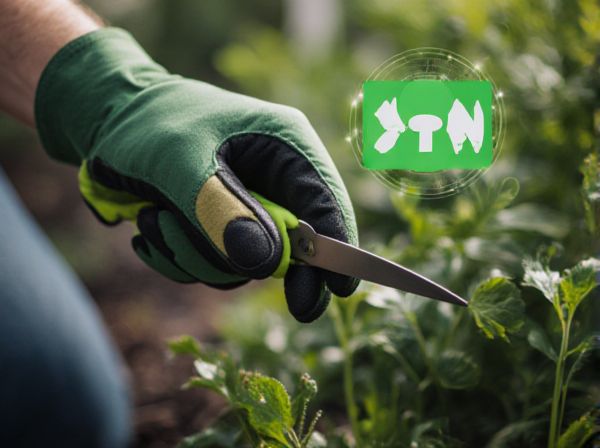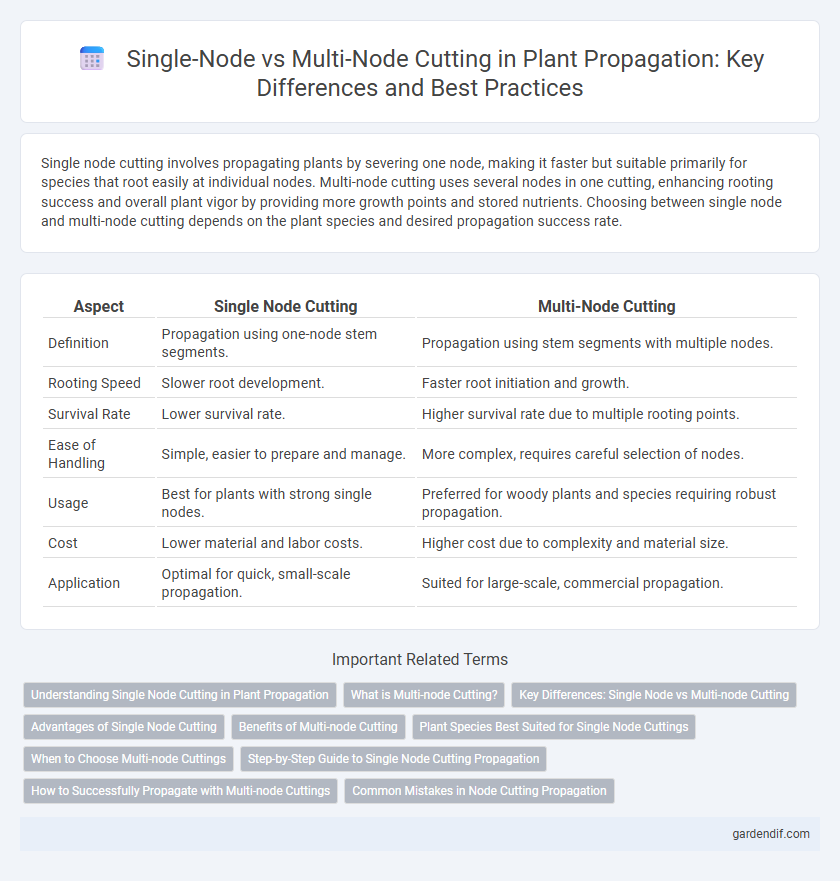
Single Node Cutting vs Multi-node Cutting Illustration
Single node cutting involves propagating plants by severing one node, making it faster but suitable primarily for species that root easily at individual nodes. Multi-node cutting uses several nodes in one cutting, enhancing rooting success and overall plant vigor by providing more growth points and stored nutrients. Choosing between single node and multi-node cutting depends on the plant species and desired propagation success rate.
Table of Comparison
| Aspect | Single Node Cutting | Multi-Node Cutting |
|---|---|---|
| Definition | Propagation using one-node stem segments. | Propagation using stem segments with multiple nodes. |
| Rooting Speed | Slower root development. | Faster root initiation and growth. |
| Survival Rate | Lower survival rate. | Higher survival rate due to multiple rooting points. |
| Ease of Handling | Simple, easier to prepare and manage. | More complex, requires careful selection of nodes. |
| Usage | Best for plants with strong single nodes. | Preferred for woody plants and species requiring robust propagation. |
| Cost | Lower material and labor costs. | Higher cost due to complexity and material size. |
| Application | Optimal for quick, small-scale propagation. | Suited for large-scale, commercial propagation. |
Understanding Single Node Cutting in Plant Propagation
Single node cutting involves using a single stem segment containing one node and an attached leaf or bud to propagate new plants, emphasizing efficient root and shoot development from minimal plant material. This technique promotes faster rooting and reduces resource use compared to multi-node cuttings, which contain multiple nodes and often require more care. Understanding the physiological role of the node is crucial, as it contains meristematic tissue essential for generating new roots and shoots in single node propagation.
What is Multi-node Cutting?
Multi-node cutting involves removing several nodes from a plant stem to create multiple cuttings simultaneously, increasing the number of propagation points. This technique enhances the chances of successful rooting because each node contains meristematic tissue capable of developing roots. Compared to single node cutting, multi-node cutting optimizes resource use and accelerates the propagation process.
Key Differences: Single Node vs Multi-node Cutting
Single node cuttings involve propagating plants using a single stem node, which typically results in faster root development and higher rooting success rates due to concentrated growth hormones at the node. Multi-node cuttings include several nodes on the stem, providing increased nutrient reserves and a greater chance of multiple shoots emerging, enhancing overall plant vigor. The choice between single node and multi-node cutting depends on the species' rooting characteristics and desired propagation speed.
Advantages of Single Node Cutting
Single node cutting offers precise control over genetic propagation, ensuring higher success rates in root development due to focused nutrient allocation. This method reduces the risk of disease transmission as only one node is involved, minimizing contamination compared to multi-node cutting. Enhanced efficiency in single node cutting allows for quicker acclimatization and growth, making it ideal for plants requiring meticulous propagation techniques.
Benefits of Multi-node Cutting
Multi-node cutting enhances propagation success by allowing multiple growth points to develop simultaneously, leading to faster root establishment and increased plant vigor. This method improves genetic consistency and uniformity compared to single node cuttings by promoting more robust and healthy specimens. Higher survival rates and accelerated growth cycles result in more efficient and scalable plant production.
Plant Species Best Suited for Single Node Cuttings
Plant species best suited for single node cuttings typically include herbaceous plants such as Coleus, Pothos, and Philodendron, which root quickly from individual nodes due to their high auxin concentration. Softwood and semi-hardwood plants like hydrangeas and fuchsias also respond well to single node cutting techniques, enabling efficient propagation with minimal resource use. These species benefit from single node cuttings as this method promotes faster root development and higher success rates compared to multi-node cuttings in controlled environments.
When to Choose Multi-node Cuttings
Multi-node cuttings are ideal when propagating woody plants that have matured beyond the juvenile stage, as they retain more stored nutrients and hormonal balance to support root development. This method is particularly effective for species with slow rooting tendencies or when a higher success rate is required, such as in commercial nursery operations. Employing multi-node cuttings enhances the likelihood of successful propagation by providing multiple potential rooting sites and increased energy reserves.
Step-by-Step Guide to Single Node Cutting Propagation
Single node cutting propagation involves selecting a healthy stem and cutting just one node with an attached leaf to encourage root growth, ensuring the cutting is taken at a 45-degree angle to maximize nutrient absorption. After removing lower leaves, dip the node in rooting hormone and plant it in a well-draining medium like peat or perlite to maintain moisture while preventing rot. Place the cutting in a warm, humid environment with indirect light to promote root development, which typically occurs within 2-4 weeks.
How to Successfully Propagate with Multi-node Cuttings
Successful propagation with multi-node cuttings involves selecting healthy stem sections containing multiple nodes to enhance root development and increase survival rates. Ensuring proper moisture levels, using rooting hormones, and maintaining optimal humidity and temperature accelerates root initiation across all nodes. This method provides a higher chance of successful plant establishment compared to single-node cuttings by leveraging the regenerative capacity of multiple nodes.
Common Mistakes in Node Cutting Propagation
Common mistakes in node cutting propagation include cutting too close to the node, which can damage the meristem and prevent new growth, or cutting too far away, leaving insufficient tissue for rooting. Another frequent error is failing to remove leaves near the cutting site, which can increase the risk of rot and reduce shoot development. Ensuring clean, precise cuts and proper leaf removal enhances root formation and overall propagation success.
Single Node Cutting vs Multi-node Cutting Infographic

 gardendif.com
gardendif.com